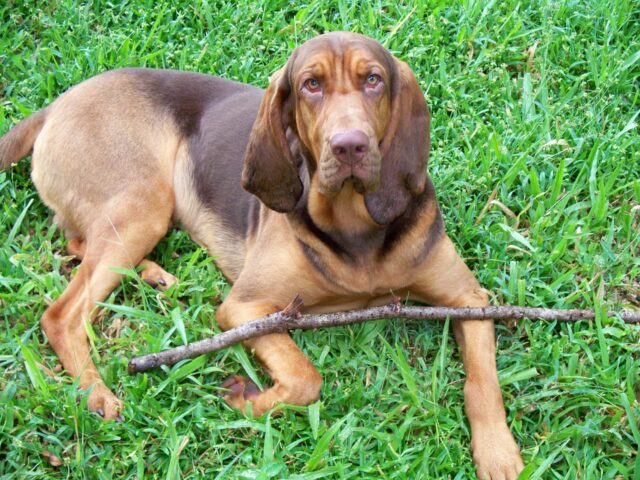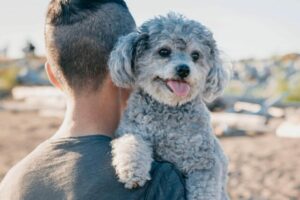

1. How can I tell if my Bloodhound is entering their senior years?
Bloodhounds are typically considered seniors around 7 to 9 years old, although this can vary based on individual health and genetics. Signs that your Bloodhound is entering their senior years include a noticeable decrease in energy levels and a preference for more restful activities. They may become less enthusiastic about vigorous exercise and more inclined to nap or enjoy quieter pastimes. Physical changes such as graying fur, particularly around the muzzle, and a decrease in muscle tone are common indicators of aging. Additionally, they might experience stiffness or difficulty moving, especially after resting, which can indicate arthritis. Behavioral changes, such as increased anxiety, confusion, or changes in sleep patterns, may also occur. Regular veterinary check-ups are essential to monitor these changes and manage any emerging health issues, ensuring your Bloodhound remains healthy and comfortable in their senior years.
2. What are common health issues in aging Bloodhounds?
As Bloodhounds age, they can become prone to several common health issues. Arthritis and hip dysplasia are prevalent, causing pain and stiffness that can affect mobility. They are also at risk for bloat, a potentially life-threatening condition where the stomach twists, which requires immediate medical attention. Eye problems, such as cataracts and progressive retinal atrophy, can impair their vision. Additionally, Bloodhounds may experience heart conditions, including dilated cardiomyopathy, and thyroid issues like hypothyroidism. Skin problems, including infections and dermatitis, are also common due to their loose skin. Regular veterinary care, including screenings for these conditions, is crucial for early detection and management, ensuring your Bloodhound has a good quality of life in their senior years. Maintaining a healthy weight, providing proper nutrition, and ensuring regular exercise can help mitigate some of these risks.
3. How should I adjust my Bloodhound’s diet as they age?
As Bloodhounds age, their metabolism slows down, and they may become less active, increasing the risk of weight gain. Adjusting their diet to maintain a healthy weight and support their overall health is important. Senior dog food formulas are typically lower in calories but contain higher levels of essential nutrients, such as protein and fiber, to support aging muscles and digestion. These formulas often include supplements like glucosamine and chondroitin for joint health and omega-3 fatty acids for a healthy coat and skin. It’s also beneficial to feed smaller, more frequent meals to aid digestion and prevent obesity. Always ensure your dog has access to fresh water. Consult your veterinarian to create a diet plan tailored to your dog’s specific needs, especially if they have health issues like arthritis or bloat risk. Avoid feeding immediately before or after exercise to reduce the risk of bloat.
4. How much exercise does an aging Bloodhound need?
While aging Bloodhounds may not have the same energy levels as in their younger years, regular exercise is still important for maintaining their health and mobility. Aim for at least 30 minutes of light to moderate exercise daily. This can include activities like leisurely walks, gentle playtime, or even some indoor activities like scent games, which are mentally stimulating. Exercise helps maintain a healthy weight, strengthens muscles, and supports joint health, which is particularly important for Bloodhounds prone to arthritis and hip dysplasia. Be mindful of their physical limitations and watch for signs of fatigue or discomfort, adjusting the intensity and duration of exercise accordingly. Avoid exercise in extreme heat, as Bloodhounds can be prone to overheating due to their large size and thick coat. Always consult your vet before making changes to your exercise routine, especially if they have existing health issues.
5. How can I help my Bloodhound manage arthritis?
Arthritis is a common issue in aging Bloodhounds, causing joint pain and stiffness. To help manage arthritis, maintain a healthy weight for your dog to reduce stress on their joints. Provide a comfortable, orthopedic bed to support their joints while they rest. Regular, low-impact exercise, such as gentle walks or swimming, can help maintain mobility and muscle strength. Dietary supplements like glucosamine and chondroitin can support joint health, and omega-3 fatty acids can reduce inflammation. Your veterinarian may also recommend anti-inflammatory medications or pain relievers to manage discomfort. In some cases, physical therapy or acupuncture may be beneficial. Regular veterinary check-ups are crucial for monitoring the progression of arthritis and adjusting the treatment plan as needed. Ensuring your Bloodhound stays active and comfortable can significantly improve their quality of life.
6. Should I be concerned about my Bloodhound’s dental health?
Dental health is crucial for aging Bloodhounds, as they are prone to dental issues such as plaque buildup, gum disease, and tooth decay. Poor dental health can lead to pain, difficulty eating, and more serious health problems like heart disease. Regular brushing with dog-specific toothpaste is the best way to maintain dental hygiene. Dental chews and toys designed to clean teeth can also help reduce plaque and tartar buildup. It’s important to schedule annual dental check-ups with your vet, who can perform professional cleanings and address any issues early on. If your Bloodhound shows signs of dental problems, such as bad breath, drooling, or reluctance to eat, seek veterinary care immediately. Maintaining good dental hygiene can significantly improve their overall health and quality of life.
7. How can I keep my aging Bloodhound comfortable at home?
To keep your aging Bloodhound comfortable, consider making a few adjustments around the home. Provide a supportive, orthopedic bed to relieve pressure on their joints and ensure they have a warm, cozy place to rest. If your dog has difficulty navigating stairs or getting onto furniture, consider using ramps or pet steps. Keep their food and water bowls at a comfortable height to reduce strain on their neck and back. Regular grooming, including checking for skin irritations or infections, is important to keep them comfortable, especially with their loose skin and long ears. Maintaining a calm and quiet environment can help reduce anxiety and stress, particularly if they have developed vision or hearing impairments. Additionally, ensure that they have access to a comfortable outdoor space for bathroom breaks and fresh air.
8. What should I do if my Bloodhound is losing their hearing?
If your Bloodhound is experiencing hearing loss, there are several ways to help them adjust. Use hand signals or visual cues for commands, as these can be more effective than verbal ones. Ensure you approach them from the front to avoid startling them and consider using vibrations, such as gently tapping the floor or their bed, to get their attention. Creating a consistent routine can help them feel secure and reduce anxiety. Keep them on a leash when outside, as they may not hear potential dangers like approaching vehicles. At home, avoid loud noises that could startle them, and provide a safe, calm environment. Consult your vet for further advice and possible treatments, and consider using products like vibrating collars if recommended.
9. How do I manage my Bloodhound’s weight as they age?
Managing your Bloodhound’s weight is crucial as they age to prevent obesity and related health issues like diabetes and joint problems. Start by adjusting their diet to include fewer calories, and opt for high-quality senior dog food with balanced nutrients. Measure their food portions accurately and avoid giving them too many treats. Incorporate regular, moderate exercise into their routine to help maintain a healthy weight and muscle mass. Activities like short walks, gentle play, or even swimming are ideal, as they provide exercise without straining the joints. Regular weigh-ins and veterinary check-ups can help monitor their weight and overall health. Addressing weight management early can prevent more serious health complications and improve their quality of life in their senior years.
10. How can I mentally stimulate my aging Bloodhound?
Mental stimulation is important for aging Bloodhounds to keep their minds sharp and prevent cognitive decline. Engage them with interactive toys, such as puzzle feeders, which can challenge their problem-solving skills and provide entertainment. Training sessions, even if it’s just reinforcing basic commands, can be mentally stimulating and help maintain their cognitive abilities. Scent games, like hiding treats for them to find, can also be enjoyable and mentally engaging. Regular socialization, whether with other dogs or new people, can provide new experiences and mental engagement. Keep activities short and positive, and tailor them to your dog’s individual needs and energy levels. Regularly rotating their toys and introducing new ones can keep their interest piqued and prevent boredom.

